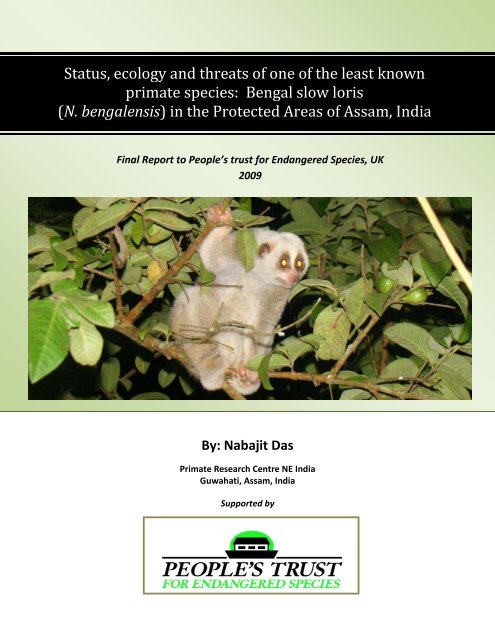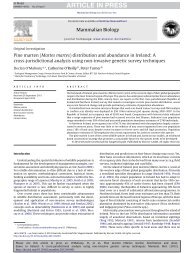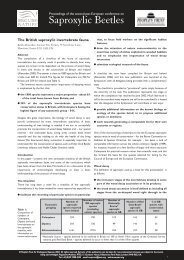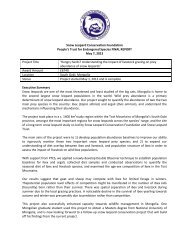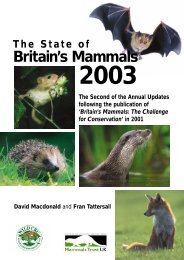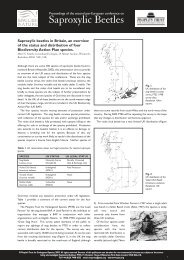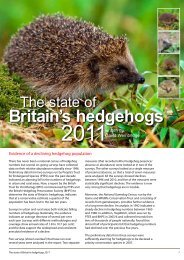Status, ecology and threats of one of the - People's Trust for ...
Status, ecology and threats of one of the - People's Trust for ...
Status, ecology and threats of one of the - People's Trust for ...
- No tags were found...
Create successful ePaper yourself
Turn your PDF publications into a flip-book with our unique Google optimized e-Paper software.
03IntroductionThe infra-order lorisi<strong>for</strong>mes <strong>of</strong> order primate is <strong>the</strong> ‘least known <strong>of</strong> all primate’ (Nekaris& Bearder, 2007) having 34 recognized nocturnal species under three subfamilies Galaginae(galagos), Perodicticinae (pottos <strong>and</strong> angwantibos) <strong>and</strong> Lorisidae (lorises). The Lorisidaerepresented by two species in India - Loris lydekkerianus (Slender loris) <strong>and</strong> Nycticebusbengalensis (Bengal slow loris) which is endemic to south <strong>and</strong> Sou<strong>the</strong>ast Asia. The genusNycticebus <strong>of</strong> infraorder lorisi<strong>for</strong>mes, native to South <strong>and</strong> Sou<strong>the</strong>ast Asia is <strong>one</strong> <strong>of</strong> <strong>the</strong> leaststudied Asian primates, owing to its nocturnal lifestyle, cryptic <strong>and</strong> its small body size (Groves1998, 2006; Srivastava & Mohnot 2001). Five species <strong>of</strong> genus Nycticebus (N. bengalensis, N.coucang, N. javanicus, N. menagensis <strong>and</strong> N. pygmaeus) are recognized based on geneticanalysis (Roos 2003, Br<strong>and</strong>on- J<strong>one</strong>s et al., 2004; Chen et al., 2006; Nekaris et al., 2007). Asstudies <strong>of</strong> this previously unknown genus became available, so does <strong>the</strong> dramatic conservationcrisis that <strong>the</strong>y face. For example, in 2007, Nycticebus became <strong>the</strong> first primate genus to be uplisted to CITES I in over 15 years <strong>and</strong> Javan slow loris (N. javanicus) was placed on <strong>the</strong> list <strong>of</strong>top 25 most endangered primate species <strong>of</strong> <strong>the</strong> World (IUCN 2008).The five species <strong>of</strong> genus Nycticebus are endemic to South <strong>and</strong> Sou<strong>the</strong>ast Asia, eachhaving its own significantly smaller range from Assam, Nor<strong>the</strong>ast India to Mindanao <strong>and</strong> isl<strong>and</strong>s<strong>of</strong> <strong>the</strong> Sunda Shelf (Mackinnon <strong>and</strong> Mackinnon, 1987) as follows:a) Pygmy slow loris (N. pygmaeus) - found in Cambodia, South China, Laos <strong>and</strong> Vietnam.b) Bengal or Nor<strong>the</strong>rn slow loris (N. bengalensis ) - found in Burma, Cambodia, SouthChina, Bhutan, North-east India, Laos, Thail<strong>and</strong> north <strong>of</strong> <strong>the</strong> Isthmus <strong>of</strong> Kra <strong>and</strong>Vietnam.c) Greater slow loris (N. coucang) - found in Ind<strong>one</strong>sia on Natuna Isl<strong>and</strong> <strong>and</strong> Sumatra,peninsular Malaysia <strong>and</strong> Thail<strong>and</strong> south <strong>of</strong> <strong>the</strong> Isthmus <strong>of</strong> Kra.d) Bornean slow loris (N. menagensis) - found in Brunei, Kalimantan in Ind<strong>one</strong>sia <strong>and</strong> <strong>the</strong>Malaysian states <strong>of</strong> Sabah <strong>and</strong> Sarawak.e) Javan slow loris (Nycticebus javanicus) - found in Ind<strong>one</strong>sia on <strong>the</strong> isl<strong>and</strong> <strong>of</strong> Java.
04Bengal slow loris Nycticebus bengalensis has <strong>the</strong> largest geographic range among <strong>the</strong>slow lorises <strong>and</strong> this species remains very poorly researched, both in <strong>the</strong> wild <strong>and</strong> in captivity. Inmany Asian countries slow lorises are in high dem<strong>and</strong> <strong>for</strong> traditional medicine <strong>and</strong> pet trade.With <strong>the</strong>ir low reproduction rate, wild populations <strong>of</strong> Nycticebus cannot withst<strong>and</strong> <strong>the</strong>se largescale<strong>of</strong>f-takes <strong>and</strong> many authors report regional population declines (Nekaris et al 2008). InIndia, <strong>the</strong> distribution <strong>of</strong> Bengal slow lorises is confined only to <strong>the</strong> 7 nor<strong>the</strong>astern states <strong>of</strong> India(Br<strong>and</strong>on-J<strong>one</strong>s et al., 2004; Choudhury, 1992; Srivastava, 1999). In Assam, Nor<strong>the</strong>ast Indiaslow loris are seriously suffering from escalating habitat destruction, hunting ,medicinal <strong>and</strong> pettrades despite being included in Schedule I Species list as per Wildlife Protection Act <strong>of</strong> India,1972. Recently IUCN listed <strong>the</strong> species as ‘Vulnerable’ throughout its distribution range (IUCN2008) with limited conservation attention. No long term ecological studies have been conductedso far on Bengal slow loris in India except a h<strong>and</strong>ful <strong>of</strong> distribution records (Choudhury, 1992;Radhakrishna et al, 2004). Lack <strong>of</strong> in<strong>for</strong>mation about <strong>the</strong> current population, habitat status, <strong>and</strong>general <strong>ecology</strong> <strong>of</strong> slow loris dem<strong>and</strong> specific studies to <strong>for</strong>mulate a comprehensive as well as asite specific conservation action plan <strong>for</strong> <strong>the</strong> species <strong>and</strong> its habitats as it is an important seeddisperser, pollinator (Nekaris <strong>and</strong> Bearder, 2007). It also prefers dense <strong>for</strong>ests, indicating <strong>the</strong>health <strong>of</strong> <strong>for</strong>est ecosystem (Gupta, 2001). Being ecologically unexplored <strong>and</strong> unattended, <strong>the</strong>survival threat <strong>of</strong> Bengal slow loris becomes more real in Assam due to present de<strong>for</strong>estationcrisis <strong>and</strong> <strong>the</strong> hunting. The primary threat to this species in Assam is from habitat destruction(illegal logging, slash & burn cultivation <strong>and</strong> encroachment) hunting <strong>for</strong> food, medicinal use <strong>and</strong>pet trade.Scientific synonyms <strong>of</strong> Bengal slow lorisNycticebus coucang bengalensisNycticebus c. tenasserimensis (Elliot, 1967)Nycticebus cinereus (Milne-Edwards, 1867)Nycticebus incanus (Thomas 1921)Nycticebus tardigradus (Blan<strong>for</strong>d 1888)Local Names <strong>of</strong> Bengal slow loris in IndiaIn India it is commonly known as following in different languages:
05Assamese: Lajuki-b<strong>and</strong>ar; Hindi: Sharimindii-billi; Bengali: Lajjawati-b<strong>and</strong>ar; Garo:Galwee, Durok; Mizo: Sahuai; Manipuri: Samrok gamkok; Rukni: Mukhra ochai;Khasi: Yapnang; Bodo: Nilaji makhra; Rankhol: Zong ochai; Hmar Kuki: Mitungki.IdentificationSlow lorises are robust, compact animals with short <strong>and</strong> dense woolly fur. Lorises havevery large eyes, which are directed <strong>for</strong>ward. A prominent stripe down <strong>the</strong>ir back <strong>and</strong> lack<strong>of</strong> a visible tail make it easy to distinguish slow lorises from o<strong>the</strong>r small mammals. Withcreamy or white colored neck with a prominent stripe, ear encased by white or creamyfur, eye <strong>for</strong>k are light colored or sometimes not present, having dark rim around eyes are<strong>the</strong> distinctive identification characters <strong>of</strong> a Bengal slow loris separating it from o<strong>the</strong>rfour species <strong>of</strong> slow lories. With a length <strong>of</strong> 26-38 cm <strong>and</strong> a weight <strong>of</strong> up to 2 kg, is <strong>the</strong>largest Nycticebus species. Their tightly clinging h<strong>and</strong>s <strong>and</strong> feet have human-like nails.The nail on <strong>the</strong> second digit <strong>of</strong> <strong>the</strong> foot is elongated <strong>and</strong> rolled up to <strong>for</strong>m a groomingclaw. They can maintain a grip while remaining completely immobile <strong>for</strong> long periodsdue to a specialized network <strong>of</strong> blood vessels in <strong>the</strong> limbs.Fig 1: Bengal slow loris (Nycticebus bengalensis) in Assam, NE India
06Finding slow loris in nightIn darkness with torchlight, head lamp or o<strong>the</strong>r light, <strong>the</strong> tapetum lucidum in <strong>the</strong> eyes <strong>of</strong><strong>the</strong> animals (reflecting layer <strong>of</strong> cells behind <strong>the</strong> retina) causes a reflection well visible aslong as <strong>the</strong> animal is looking towards <strong>the</strong> light (Pariente,1979). In Nycticebus caucang,strong orange or orange-red reflection (Barrett 1984) occurs <strong>and</strong> similar pattern <strong>of</strong> eyeshine in night found in Nycticebus bengalensis also.Distribution rangeN.bengalensis is endemic to south <strong>and</strong> Sou<strong>the</strong>ast Asia, found in <strong>the</strong> following countries:Bangladesh, Nor<strong>the</strong>ast India, Bhutan, Sou<strong>the</strong>rn China, Lao People’s DemocraticRepublic, Myanmar, Thail<strong>and</strong>, Philippines <strong>and</strong> Vietnam (Br<strong>and</strong>on-J<strong>one</strong>s et al. 2004;Gursky 2002; Groves 2001) ( Tab: 1). This species is found in tropical evergreen, semievergreen,tropical mixed deciduous, <strong>and</strong> sub-tropical broadleaf type <strong>for</strong>ests in Nor<strong>the</strong>astIndia (Choudhury, 1992).Tab 1: Distribution range <strong>of</strong> Bengal slow loris Nycticebus bengalensisCountryRegionBangladeshRecorded e.g. from Chittagong Hill Tracts <strong>and</strong> from Garo Hills(WTB undated).Bhutan Sou<strong>the</strong>rn Bhutan, area bordering Assam <strong>of</strong> Nor<strong>the</strong>astIndia(Choudhury 2008).IndiaNor<strong>the</strong>ast India (States <strong>of</strong> Assam, Arunachal Pradesh, Mizoram,Nagal<strong>and</strong>, Meghalaya, Manipur <strong>and</strong> Tripura (Srivastava &Mohnot 2001; Choudhury 1992).China In Yunnan <strong>and</strong> in southwest Guangxi (CSIS 2006; Bangjie 1985).Lao People’s DemocraticRepublicHave been recorded in <strong>the</strong> north, central, <strong>and</strong> sou<strong>the</strong>rn part <strong>of</strong> <strong>the</strong>country (Duckworth et al. 1999).Thail<strong>and</strong>Distributed over most <strong>of</strong> <strong>the</strong> country areas (Schulze & Groves2004).Viet NamIt is known from 12 24 protected areas (Long et al. 2000; SFNC2000, Dang 1998).PhilippinesIn <strong>the</strong> isl<strong>and</strong>s <strong>of</strong> Simunul, Bongao, Sanga Sanga, <strong>and</strong> Tawitawi,where Tawitawi represents this species most eastern most limit(Fooden, 1991).MyanmarRecorded from Bhamo, Sumprabum, Kindat, Chin Hills, Pa<strong>the</strong>in,Thaungdaung <strong>and</strong> Pegu (Groves 1971).
Map courtesy: IUCN websiteFig 2: IUCN Bengal slow loris distribution range07
Project Goal <strong>and</strong> ObjectivesProject goal:‣ To collect data on <strong>the</strong> present population <strong>and</strong> habitat status <strong>and</strong> demography as well asfeeding <strong>ecology</strong> <strong>and</strong> habitat utilization pattern <strong>of</strong> Bengal slow loris in Assam to support longtermconservation <strong>of</strong> <strong>the</strong> species in Assam.‣ To generate reliable in<strong>for</strong>mation on, <strong>and</strong> create a database <strong>for</strong> Bengal slow loris, populationstatus, habitat use, general <strong>ecology</strong> <strong>and</strong> conservation issues, to be used as a base <strong>for</strong> <strong>the</strong>IUCN Species Survival Commission Primate Specialist Group classification.‣ Determination <strong>of</strong> <strong>the</strong> major <strong>threats</strong> to <strong>the</strong> species in Assam as it is <strong>the</strong> part <strong>of</strong> NE Indiawhere Bengal slow loris found.Specific Objectives:Survey: -‣ To know <strong>the</strong> present distribution <strong>and</strong> population status as well as demography <strong>of</strong> Bengalslow loris in <strong>the</strong> protected areas (PAs) <strong>of</strong> Assam.Habitat assessment: -‣ To identify <strong>and</strong> compare <strong>the</strong> habitat <strong>of</strong> <strong>the</strong> Bengal slow loris in term <strong>of</strong> quantitativevegetation structure, density, <strong>and</strong> species composition.Study general <strong>ecology</strong> & home range:‣ To find out food plants used by Bengal slow loris in different habitat type.‣ To obtain comparative account <strong>of</strong> feeding <strong>ecology</strong> including <strong>the</strong>ir diet, quantity <strong>of</strong><strong>for</strong>age, frequency <strong>of</strong> consumption in different habitat conditions.‣ To obtain home range <strong>and</strong> habitat utilization pattern <strong>of</strong> Bengal slow loris.Conservation & Threat analysis: -‣ To evaluate <strong>the</strong> <strong>threats</strong> from various angle viz., (a) population, (b) demography, (c)quality <strong>of</strong> habitat.‣ To provide training <strong>and</strong> valuable work experience on slow loris research to members <strong>of</strong><strong>the</strong> survey team as well as <strong>the</strong> <strong>for</strong>est staffs, as an emerging Biological Resources Unit.08
09Study areaThe immense variety <strong>of</strong> <strong>the</strong> climatic, edaphic <strong>and</strong> altitudinal variations in India haveresulted in a great range <strong>of</strong> ecological habitats <strong>for</strong> which Nor<strong>the</strong>ast India takes <strong>the</strong> pride <strong>of</strong> place.Lying between 22--30 0 N latitude <strong>and</strong> 89--97 0 E longitude, <strong>and</strong> sprawling over 2,62,379 sq.km.,It was <strong>the</strong> part <strong>of</strong> <strong>the</strong> northward migrating ‘Deccan Peninsula’ that first touched <strong>the</strong> Asianl<strong>and</strong>mass after <strong>the</strong> breakup <strong>of</strong> ‘Gondwanal<strong>and</strong>’ in <strong>the</strong> early Tertiary period (Molnar 1986).Nor<strong>the</strong>ast India is thus <strong>the</strong> geographical ‘gateway’ <strong>for</strong> much <strong>of</strong> India’s flora <strong>and</strong> fauna, <strong>and</strong> as aconsequence, <strong>the</strong> region is <strong>one</strong> <strong>of</strong> <strong>the</strong> richest in biological values (Myers 1999, 2000). It is in thislowl<strong>and</strong>-highl<strong>and</strong> transition z<strong>one</strong> that <strong>the</strong> highest diversity <strong>of</strong> biomes or ecological communitiescan be found, <strong>and</strong> species diversities within <strong>the</strong>se communities are also extremely high.Nor<strong>the</strong>ast India comprised with seven states viz. Assam, Arunachal Pradesh, Mizoram,Meghalaya, Nagal<strong>and</strong>, Tripura <strong>and</strong> Manipur, blessed with a wide range <strong>of</strong> physiography <strong>and</strong> ecoclimaticconditions. The <strong>for</strong>ests in <strong>the</strong> region are extremely diverse in structure <strong>and</strong> composition<strong>and</strong> combine tropical <strong>and</strong> temperate <strong>for</strong>est types, alpine meadows <strong>and</strong> savanna. The state <strong>of</strong>Assam represents <strong>the</strong> transition z<strong>one</strong> between <strong>the</strong> Indian, Indo-Malayan <strong>and</strong> Indo-Chinese biogeographicalregions <strong>and</strong> a meeting place <strong>of</strong> <strong>the</strong> Himalayan Mountains <strong>and</strong> Peninsular India. TheState situated within 24 ° 07' to 28°00' North Latitude <strong>and</strong> 89°42' to 96°02' East longitude. It is <strong>the</strong>area in <strong>the</strong> whole <strong>of</strong> <strong>the</strong> South Asia with extremely rich <strong>for</strong>ests serving as a habitat <strong>of</strong> a variety <strong>of</strong>primate, carnivore, herbivore <strong>and</strong> birds. The recorded <strong>for</strong>est area is 26,832 km2, which is 34.21%<strong>of</strong> <strong>the</strong> total geographic area <strong>of</strong> <strong>the</strong> state. According to <strong>the</strong> legal classification, Reserved Forestsconstitute 66.58% <strong>and</strong> Un-classed Forests, 33.42%.Owing to <strong>the</strong> location in <strong>the</strong> sub-tropical z<strong>one</strong> <strong>and</strong> <strong>the</strong> prevalence <strong>of</strong> <strong>the</strong> Monsoonclimate, <strong>the</strong> l<strong>and</strong>mass <strong>of</strong> Assam possesses mainly evergreen, semi-evergreen <strong>and</strong> deciduoustrees. However, depending upon <strong>the</strong> intensity <strong>of</strong> precipitation, humidity <strong>and</strong> temperature, <strong>the</strong><strong>for</strong>ests are classified as wet or dry. Variation occurs in growth <strong>of</strong> different species <strong>of</strong> trees indifferent parts <strong>of</strong> <strong>the</strong> state due to different soil <strong>and</strong> ground water regimes <strong>and</strong> o<strong>the</strong>r geographical
10factors. The vegetation cover found in Assam can be classified into six major <strong>for</strong>est types viz.Tropical Wet Evergreen, Tropical Semi-Evergreen, Tropical Moist Deciduous, SubtropicalBroad Leaved Hill, Sub Tropical pine <strong>and</strong> Littoral Swamp <strong>for</strong>ests (Champion & Seth 1968).In Assam, <strong>the</strong>re are 5 National Parks (NP) <strong>and</strong> 18 Wildlife Sanctuaries (WLS) coveringan area <strong>of</strong> about 0.4 million ha constituting 4.98% <strong>of</strong> <strong>the</strong> total geographic area <strong>of</strong> <strong>the</strong> state. In thisproject work on Bengal slow loris, we have selected <strong>the</strong> following 13 Protected Areas (PAs) <strong>of</strong>Assam (Table: 2) on <strong>the</strong> basis <strong>of</strong> different habitat structure <strong>and</strong> to cover distant geographiclocation within <strong>the</strong> state <strong>of</strong> Assam. Survey covered 3 National Parks <strong>and</strong> 10 Wildlife Sanctuaries<strong>of</strong> Assam. In addition to this we also surveyed <strong>one</strong> National Park in Arunachal Pradesh <strong>and</strong> 2o<strong>the</strong>r Reserve Forests (RF) in Assam.Tab 2: Bengal slow loris surveyed PAs <strong>of</strong> Assam.Sl No Surveyed Areas Total area in sq.km District1 Manas NP 500 Baska2 Nameri NP 200 Sonitpur3 Dibru Saikhowa NP 340 Tinsukia4 Chakrasilla WLS 45.50 Kokrajhar5 Barnadi WLS 26.22 Kamrup6 Amsang WLS 78.64 Kamrup7 Laokhowa WLS 70.13 Nagaon8 Burachapori WLS 44.06 Sonitpur9 Bherjan -Borajan WLS 7.22 Tinsukia10 Dehing Patkai WLS 111.19 Dibrugarh11 Gibbon WLS 20.98 Jorhat12 Garampani WLS 6.05 Golaghat13 Nambor-Doigurung WLS 97.15 Golaghat
11MethodologyBengal slow loris survey:The survey <strong>of</strong> Bengal slow loris was begun in February 2008 <strong>and</strong> ended in May 2009. Assurvey coverd a large area within a stipulated time period, we adopt <strong>the</strong> ‘recce’ (reconnaissance)survey (Walsh <strong>and</strong> White, 1999) in conjunction with line transects (Burnham et al., 1980)method; <strong>the</strong> ‘Recce-Survey Transects’ (MIKE, 2006) to estimate loris encounter rate. Surveycarried out at night (1800 – 0200 h) on foot <strong>and</strong> by vehicle (where night walking is prohibited).Two /three transects were selected r<strong>and</strong>omly to avoid bias (White <strong>and</strong> Edwards 2000) <strong>for</strong> eachnight; <strong>one</strong> is during early part <strong>of</strong> night (1800 – 2130 h) <strong>and</strong> ano<strong>the</strong>r is middle <strong>of</strong> night (2230—0200 h). All types <strong>of</strong> vegetation searched by headlamp (Ptezl headlamp) <strong>for</strong> detection <strong>of</strong> loristhat produces an orange red refection from its eye. This anatomical feature enhances <strong>the</strong>irnocturnal vision in that it increases <strong>the</strong> amount <strong>of</strong> light reflected back through <strong>the</strong> receptors(Wolin, 1974). The index used <strong>for</strong> estimating relative abundance is <strong>the</strong> loris encounter rate, or‘sightings’ per km (Anonymous, 1981; Su<strong>the</strong>rl<strong>and</strong>, 2002).Habitat assessment:Habitat assessment studies were d<strong>one</strong> by strip sampling method (Strushsaker, 1975 <strong>and</strong>Williamson, 1993) in daytime to characterize <strong>the</strong> different habitats, where slow loris isencountered in nights in <strong>the</strong> surveyed areas. In <strong>the</strong> case <strong>of</strong> smaller mammals it has been shownthat <strong>the</strong>ir distribution is <strong>of</strong>ten associated with <strong>the</strong> availability <strong>of</strong> suitable habitats (Entwistle <strong>and</strong>Stephenson, 2000). All <strong>the</strong> <strong>for</strong>est types <strong>of</strong> loris encountered area, containing differentmicrohabitats was considered <strong>for</strong> this study. Initially plants were identified by local name with<strong>the</strong> help <strong>of</strong> local field assistants <strong>and</strong> later on plant species were identified with <strong>the</strong> help <strong>of</strong>st<strong>and</strong>ard field guide following Hajra <strong>and</strong> Jain, (1978) <strong>and</strong> Kanjilal et al. (1934-1940). Datarelated to density <strong>of</strong> <strong>the</strong> understory vegetation, <strong>the</strong> percentage canopy cover <strong>and</strong> <strong>the</strong> height <strong>of</strong> <strong>the</strong>canopy at each observation were recorded. Understory density was estimated on a scale from 1 to5, canopy cover was estimated as percentage cover to <strong>the</strong> nearest 5% <strong>and</strong> <strong>the</strong> height <strong>of</strong> <strong>the</strong>
12canopy was estimated to <strong>the</strong> nearest 5 m. The species <strong>of</strong> tree, shrub, or liana on which animalwas found was recorded as well as its diameter at breast height (DBH) measured with a tapemeasure. The DBH <strong>of</strong> <strong>the</strong> entire tree species was d<strong>one</strong> in a 50 X 10 meter strip where loris wasencountered in night.General <strong>ecology</strong> & Home range:Ad labium sampling <strong>and</strong> focal animal sampling are adopted as per Altmann (1974). Forbehavioral data recording, we found out <strong>one</strong> slow loris <strong>the</strong>n follow <strong>the</strong> animal in a specific studysite (Gibbon WLS). We used head-lamp (Petzl headlamp) <strong>and</strong> binoculars <strong>for</strong> observing <strong>the</strong>targeted loris individual. We concentrated our ef<strong>for</strong>t to follow a loris continuously from itssleeping site at dusk to its sleeping site at dawn, whenever possible. Data relating to feeding,quantity <strong>of</strong> <strong>for</strong>age <strong>and</strong> frequency <strong>of</strong> consumption was recorded during focal animal sampling.When food was consumed, identification <strong>of</strong> foodstuff was made; if this could not be ascertainedfrom observation, food materials dropped by <strong>the</strong> animal were collected <strong>for</strong> later identification.Feeding trees are identified to species level on site or are tagged <strong>for</strong> later identification ifunknown. Besides focal animal sampling, opportunistic observation <strong>of</strong> occasional, but importantbehaviors is also d<strong>one</strong> in Ad labium sampling (Altmann 1974).Feeding behaviour was carried out from March 2008 to May 2009 in Gibbon WildlifeSanctuary (26 ° 40'-- 26 ° 45' N <strong>and</strong> 94 ° 20'--- 94 ° 25' E), situated on south bank <strong>of</strong> river Bhramaputrain Assam. The <strong>for</strong>est type in <strong>the</strong> Gibbon Wildlife Sanctuary is Assam plains alluvial semievergreen <strong>for</strong>ests, sparsely interspersed with wet evergreen <strong>for</strong>est patches (Champion & Seth1968). The vegetation is composed <strong>of</strong> several canopy layers; most <strong>of</strong> <strong>the</strong> comp<strong>one</strong>nts areevergreen in character. The study area <strong>of</strong> 2098.62 h, distinctly divided into five compartmentshaving thick under storey <strong>and</strong> a canopy at a height <strong>of</strong> about 10–19 m.Conservation education:Participatory conservation education activities were carried out using different educationmodule among <strong>the</strong> fringe communities by participatory activities. Different teaching moduleswas designed at first to reach students, community leaders, sacred groups <strong>and</strong> soon allcommunity members through by different participatory activities <strong>and</strong> using different audio-visual
lectures (Sudman et al., 1982; Lang 2000; Newton 2001; Bright et at., 2002; Herremans et al.,2002 <strong>and</strong> Kramer & Kray 2006).13Result1. Slow loris surveyWe surveyed 13 different protected areas <strong>of</strong> Assam covering almost all representativeareas except sou<strong>the</strong>rn Assam. A total <strong>of</strong> 20 slow lorises were recorded from 7 different protectedareas <strong>and</strong> confirmed <strong>the</strong> presence <strong>of</strong> slow loris from 4 different protected areas from secondaryin<strong>for</strong>mation <strong>and</strong> past record <strong>of</strong> captured animals (Table: 3)We started our survey activities from February 2008 to May 2009. During this period wesurveyed <strong>the</strong> protected areas (Table: 2), which falls under <strong>the</strong> probable distribution area <strong>of</strong>Bengal slow loris (Nycticebus bengalensis) in Assam. We were <strong>for</strong>ced to temporarily withdraw<strong>the</strong> survey activities due to heavy monsoon rain during June <strong>and</strong> July 2008. It was not an easytask especially at night, since <strong>the</strong> access to <strong>the</strong> fragments was <strong>of</strong>ten difficult due to bad rainyconditions or even to <strong>the</strong> absence <strong>of</strong> existing <strong>for</strong>est trails to get to specific parts <strong>of</strong> <strong>the</strong> <strong>for</strong>ests.We partially surveyed some parts <strong>of</strong> Manas NP <strong>and</strong> Chakrasilla WLS in that time, which werecompleted after monsoon season later on. In addition to protected areas, we also surveyed teaestates (in Gibbon WLS, Padumani-Bherjan-Borajan WLS, Dehing Patkai WLS), <strong>and</strong> areasbordering <strong>for</strong>ests <strong>and</strong> villages (In Manas NP, Nameri NP, Dibru Saikhowa NP, Barnadi WLS<strong>and</strong> Chakrasilla WLS). The <strong>for</strong>est types in <strong>the</strong> surveyed areas included tropical wet evergreen,tropical semi-evergreen, tropical moist deciduous <strong>and</strong> subtropical broad leaved hill <strong>for</strong>ests.Instead <strong>of</strong> our stipulated survey sites, in addition we also surveyed two o<strong>the</strong>r Reserved Forests(Chirrang Ripu RF <strong>and</strong> Joypur RF) <strong>of</strong> Assam <strong>and</strong> <strong>one</strong> National Park <strong>of</strong> Arunachal Pradesh(Namdapha NP).Abundance estimate <strong>of</strong> Bengal slow loris in different protected areasDuring <strong>the</strong> survey we spent 99 full survey nights <strong>and</strong> 28 partial survey nights covering
14370 km long transect within PAs & RF <strong>of</strong> Assam <strong>and</strong> Arunachal Pradesh. All <strong>the</strong> lorisencountered was l<strong>one</strong> animals. Since <strong>the</strong> density or actual abundance <strong>of</strong> <strong>the</strong> species could not becalculated due to its cryptic nocturnal habits <strong>and</strong> shyness, eye shine detection is <strong>the</strong> only method<strong>of</strong> animal sighting at night - which is also very intermittent, reduces <strong>the</strong> chances <strong>of</strong> any densityestimates. During our survey ef<strong>for</strong>ts, only in 22.0% (n = 25) survey nights we were successful inencountering lorises. Because <strong>of</strong> <strong>the</strong>se difficulties workers are estimating <strong>the</strong> average encounterrate per kilometer <strong>and</strong> considered it as abundance estimate instead <strong>of</strong> true abundance.Fig 3: Slow loris in Manas National ParkFig 4: Slow loris in Nameri National ParkIn this study, <strong>the</strong> average encounter rate or abundance <strong>of</strong> <strong>the</strong> species in all <strong>the</strong> PAs <strong>of</strong>Assam was calculated to be 0.11 loris / km. This estimates varies in different protected areas aswe observed <strong>and</strong> highest abundance observed in Gibbon WLS (0.18 loris /km) followed byBorajan-Bherjan-Podumani WLS (0.17 loris / km) <strong>and</strong> Garampani WLS <strong>and</strong> Nameri NP (0.10loris / km).Fig 5: Slow loris in Bherjan-Borajan WLSFig 6: Slow loris in Garampani WLS
15It is most remarkable that in <strong>the</strong> upper Bhramaputra valley <strong>of</strong> Assam where Padumani -Bherjan -Borajan WLS, Gibbon WLS, Dehing Patkai WLS are located, 13 lorises wereencountered among <strong>the</strong> total <strong>of</strong> twenty loris sighting during this survey in 13 PAs areas <strong>of</strong>Assam. The average sighting encounter distance from transect was 14.7 m depending on <strong>the</strong>vegetation pattern <strong>and</strong> degree <strong>of</strong> disturbance <strong>of</strong> <strong>the</strong> <strong>for</strong>ests. The nearest loris encountereddistance observed in bushes <strong>and</strong> bamboo thickets (3 m & 4 m), where slow lorises wereconcealed with <strong>the</strong> local environment <strong>and</strong> immediately disappeared if disturbed.Fig 7: Map showing Bengal slow loris surveyed PAs in AssamNo lorises were seen on <strong>the</strong> transect line. On every occasion all lorises were found insolitary conditions. All lorises were seen at average heights <strong>of</strong> 12.1 m with respect to <strong>the</strong>ground. The heights, at which <strong>the</strong> animals were sighted, however made it difficult to identify
16<strong>the</strong>ir sex <strong>and</strong> age. Feeding behavior was recorded when <strong>the</strong> lorises were first detected in threeincidences (viz. <strong>one</strong> in Nameri NP <strong>and</strong> two in Gibbon WLS). Local villagers <strong>and</strong> <strong>for</strong>est staffconcurred that sightings <strong>of</strong> slow lorises had become very rare in recent years or that <strong>the</strong> specieswas no longer in areas that <strong>the</strong>y had previously inhabited.Fig 8: Slow loris in Nambor Doigurung WLSFig 9: Slow loris in Dehing Patkai WLSApart from <strong>the</strong>se protected areas, we also surveyed two Reserved Forests <strong>of</strong> Assam viz.Chirrang Ripu RF <strong>and</strong> Joypur RF which constitute <strong>the</strong> buffer area <strong>of</strong> protected areas. In <strong>the</strong>setwo reserved <strong>for</strong>ests, we encountered two animals spending ano<strong>the</strong>r 8 full survey nights <strong>and</strong> <strong>one</strong>partial survey night. The estimated abundance <strong>of</strong> <strong>the</strong> two reserved <strong>for</strong>ests was calculated to be0.06 loris/km <strong>and</strong> 0.09 loris/km respectively.Fig 10: Slow loris in Bamboo thicketsFig 11: Characteristic eye shine <strong>of</strong> Slow loris
17Fig 12: Slow loris in Chirang Reserved ForestFig 13: Slow loris in Gibbon WLSFig 15: Slow loris in Gibbon WLSFig 14: Slow loris in Gibbon WLSFig 16: Slow loris in Gibbon WLS
Table 3: Slow loris encounter rate per km in some protected areas <strong>of</strong> Assam <strong>and</strong> Arunachal PradeshSurveyed Areas Night survey Sighting rate per RemarkskmManas NP 8 full night & 3 partial night 0.08 loris/km Western most distributionrecordedNameri NP 7 full night 0.10 loris/kmDibru Saikhowa NP 6 full nights. -- One animal caught twoyear back <strong>and</strong> <strong>one</strong> animalreleased on 2006.Chakrasilla WLS 6 full night & 4 partial ----nightsLaokhowa WLS 7 full & 4 partial nights. ---- Loris sighting occur wayback in 5 years ago, asper <strong>for</strong>est <strong>of</strong>ficial.Burachapori WLS 6 full & 3 partial nights. ---Padumani -Bherjan - 6 full night. 0.17 loris/kmBorajan WLSGibbon WLS12 full night & 3 partial 0.18 loris/kmnights.Dehing Patkai WLS 10 full night & 3 partial 0.09 loris/kmGarampani WLSNambor-DoigurungWLSAmsang WLSBarnadi WLSnights3 full nights & 1 partialnights0.10 loris/km4 full nights & 2 partial 0.06 loris/kmnights6 full nights & 1 partialnight -----5 full nights & 3 partialnights -----Three animals werecaught <strong>and</strong> h<strong>and</strong>ed overto State Zoo, Assam.Loris dry body parts wereconfiscated from poacher.13 PAs <strong>of</strong> Assam 86 full & 27 partial nights. 0.11 loris/kmNamdapha NP,Arunachal Pradesh5 full nights 0.2 loris/km Good habitat <strong>for</strong> slowloris.Joypur RF, Assam 3 full nights & 1 partialnight0.09 loris/km Good habitat <strong>for</strong> slowloris.Chirrang RF, Assam 5 full nights 0.06 loris/km Western most distributionrecordedTotal99 full nights & 28 partialnights0.11 loris /km ----18Similarly we spent 5 full survey nights in Namdapha NP cum Tiger Reserve in ArunachalPradesh, which is a contiguous l<strong>and</strong>scape with Dehing Patkai WLS. From this observation <strong>the</strong>abundance <strong>of</strong> loris was calculated to be 0.2 loris / km which are quite high compared to <strong>the</strong>observation in protected areas <strong>of</strong> neighboring Assam. Thus <strong>the</strong> total animal sighted during thisstudy was 25 animals in 8 PAs <strong>and</strong> two RFs.
19Indirect evidences <strong>of</strong> slow loris presenceAlthough sighting probability was low in some <strong>of</strong> <strong>the</strong> protected areas but we confirmed <strong>the</strong>presence <strong>of</strong> slow loris in 7 PAs. In our interaction with <strong>the</strong> local fringe villagers <strong>and</strong> <strong>for</strong>est<strong>of</strong>ficials in some <strong>of</strong> protected areas <strong>the</strong> presence <strong>of</strong> loris in those areas was clearly confirmed. InBarnadi WLS, <strong>for</strong>est <strong>of</strong>ficials already confiscated some dry body parts (h<strong>and</strong> <strong>and</strong> legs) <strong>of</strong> slowloris from a poacher (Fig: 17). In Laokhowa WLS, slow loris sightings occurred way back in 5years ago, we also visited that area, where loris was sighted by a <strong>for</strong>est <strong>of</strong>ficial in day time <strong>and</strong>found a suitable habitat <strong>for</strong> slow lorises. We did not find any lorises during our survey nights inFig 17: Bengal slow loris body parts confiscated from Barnadi WLS, Assam.Dibru Saikhowa NP, but <strong>one</strong> animal was caught two year back nearby tea garden <strong>and</strong> <strong>one</strong> isreleased on 2006, which was also caught from ano<strong>the</strong>r nearby villages. Similarly three animalswere caught in nearby villages <strong>of</strong> Amsang WLS <strong>and</strong> were h<strong>and</strong>ed over to State Zoo in Guwahati.Three slow lorises were rescued from ‘Jokaikuwnargaon’ <strong>of</strong> Dibrugarh District,‘Barhola’ <strong>of</strong>Golaghat District <strong>and</strong> ‘Sakomatha tea estate’ <strong>of</strong> Sonitpur District on 6 th , 18 th June 2008 <strong>and</strong> 11 thMay 2009 respectively as reported by local news paper. Later all <strong>the</strong>se rescued lorises wereh<strong>and</strong>ed over to <strong>for</strong>est <strong>of</strong>ficials. We did not find any sign <strong>of</strong> slow loris presence in ChakrasillaWLS during our survey activities.2. Habitat characteristicsAfter survey throughout loris encountered site within <strong>the</strong> surveyed PAs in Assam, Bengalslow loris was found to be distributed in only 4 major types <strong>of</strong> <strong>for</strong>est viz., tropical wet evergreen<strong>for</strong>est, tropical semi-evergreen <strong>for</strong>est, tropical moist deciduous <strong>for</strong>est, <strong>and</strong> subtropical broad-
20leaved hill <strong>for</strong>est. According to Champion <strong>and</strong> Seth (1968), <strong>the</strong> typical evergreen tree species in<strong>the</strong>se <strong>for</strong>ests are Syzygium, Cinnamomum, Artocarpus, <strong>and</strong> Magnoliacea, <strong>and</strong> <strong>the</strong> commondeciduous species include Terminalia myriocarpa, Terminalia citrina, Terminalia tomentosa,Tetrameles spp., <strong>and</strong> Stereospermum spp. Shorea robusta is present in disturbed habitats,especially in areas that have been subjected to fire, <strong>and</strong> represents a sub-climax community.O<strong>the</strong>r Dipterocarpus species are considered to be indicative <strong>of</strong> a <strong>for</strong>est in retrogression from <strong>the</strong>tropical evergreen or as a preclimax stage. Typically, <strong>the</strong> canopy trees are 20-30 m high. Patches<strong>of</strong> <strong>for</strong>ests, scattered along <strong>the</strong> Indo-Bhutan <strong>and</strong> along <strong>the</strong> nor<strong>the</strong>rn border between Assam-Arunachal are semi-evergreen <strong>for</strong>ests. Many <strong>of</strong> <strong>the</strong>se <strong>for</strong>est patches are confined to protectedareas. One slow loris was also sighted in deciduous <strong>for</strong>ests (Chirang Ripu RF), this confirming<strong>the</strong> presence <strong>of</strong> its Western most distribution instead <strong>of</strong> IUCN (2008) distribution map.Deciduous <strong>for</strong>ests lay mainly in <strong>the</strong> ‘Sal’ (Shorea robusta) tracts areas <strong>of</strong> Western Assam.Associates <strong>of</strong> ‘Sal’ are Lagerstroemia perviflora, Kydia calycina, Schima wallichi, Careyaarborea, Gmelina arborea, Cassia fistula, Albizzia lucida. A.odoratissima, Millusa velutina,Stereospermum chelonoides etc.Habitat sampling was d<strong>one</strong> daytime where Bengal slow loris was encountered in previousnight. A total <strong>of</strong> 60 habitat sampling (50 m x 10 m plot each) was conducted in <strong>the</strong> surveyedareas. A total <strong>of</strong> 920 tree <strong>the</strong> same as or greater than 1cm DBH was measured in <strong>the</strong> total samplearea. Trees <strong>of</strong> a DBH <strong>of</strong> between 1 cm <strong>and</strong> 5 cm make up 78% <strong>and</strong> between 4 cm to above makeup 22% <strong>of</strong> <strong>the</strong> trees in <strong>the</strong> study area. It should be noted that identification <strong>of</strong> plant specimenswas still going at <strong>the</strong> time <strong>of</strong> completing this project <strong>and</strong>, <strong>the</strong>re<strong>for</strong>e, <strong>the</strong> analysis is based onapproximately only half <strong>the</strong> number <strong>of</strong> species recorded <strong>and</strong> finally identified from plots. Thus,re-examination <strong>of</strong> <strong>the</strong> dataset once finalized is imperative.The total number <strong>of</strong> plant species encountered in <strong>the</strong>se plots was 18 (excluding <strong>the</strong>unidentified species). The number <strong>of</strong> plant species in <strong>the</strong>se plots ranged from 3 to 9. In mostplots (27, 45 %), <strong>the</strong> number <strong>of</strong> species was only 3 <strong>and</strong> only in 2 plots, a total <strong>of</strong> 9 species werenoted. In 31 plots (51.7%), <strong>the</strong> number <strong>of</strong> species varied from 4 to 8 only.The canopy cover in 32 plots (53.4%) was between medium (25-50%) to very dense (75-100%). The canopy continuity in 29 plots (48.4%) was also between medium (25- 50%) to very
21dense (75-100%). The plots were very poor in herb concentration as only 16% plots were withmedium to very dense herb growth <strong>and</strong> majority (84%) were ei<strong>the</strong>r with no herb growth or verypoor herb growth (less than 25%). Shrubs were even poorer in <strong>the</strong>ir growth as only about 9%<strong>of</strong> <strong>the</strong> plots were supporting medium to very dense shrub growth, while almost 91% <strong>of</strong> <strong>the</strong> plotsei<strong>the</strong>r had no shrub growth or very poor (below 25%).There was a significant difference in tree density per study plot <strong>and</strong> mean canopy coverbetween all <strong>the</strong> loris encountered sites. The tree density was highest in Gibbon WLS, followedby Dehing Patkai WLS. Similarly Gibbon WLS had <strong>the</strong> highest mean canopy cover <strong>of</strong> 82.11%,followed by Nambor Doigurung WLS with 64.45% <strong>and</strong> Manas National Park with 57.37%.During <strong>the</strong> survey within <strong>the</strong> state <strong>of</strong> Assam <strong>and</strong> Arunachal Pradesh sighting <strong>of</strong> slowlorises occur in 15 different trees.3. Feeding behaviour:We have selected Gibbon Wildlife Sanctuary <strong>for</strong> <strong>the</strong> studies <strong>of</strong> feeding <strong>ecology</strong> as well asloris general <strong>ecology</strong>. The study has conducted 12 continuous nights with every two monthsinterval right from <strong>the</strong> months <strong>of</strong> March 2008. But it is almost impossible to find <strong>and</strong> follow aslow loris in wild to ga<strong>the</strong>r <strong>the</strong>ir eco-behavioral data without having radio collared animal. Ino<strong>the</strong>r Sou<strong>the</strong>ast Asian countries like Thail<strong>and</strong>, Vietnam, Cambodia, slow lorises eco-behavioralobservation has been made using Radio telemetry technique as such it is <strong>the</strong> prerequisite <strong>for</strong> anynocturnal solitary species.Without using any radio collared Bengal slow loris <strong>for</strong> feeding <strong>and</strong> general ecologicalstudy in this area, we have achieved a little bit success to follow <strong>the</strong> slow loris in nightcontinuously up to maximum 5 hours. In most instances we are able to follow <strong>the</strong> subject <strong>for</strong> 5min to 1 hr.The diets were assessed by direct feeding observations made during nocturnal tracking(396 h). When lorises were seen feeding, kind <strong>of</strong> food (gum, exudates, flower, plants bark,arthropod) as well as <strong>the</strong> vernacular name <strong>of</strong> <strong>the</strong> <strong>for</strong>age plant were recorded. The <strong>for</strong>age plantwere marked <strong>and</strong> visited during <strong>the</strong> day to collect leaves, fruits or flowers <strong>for</strong> identification. Theheights <strong>of</strong> <strong>the</strong> point where <strong>the</strong> animals fed estimated to <strong>the</strong> nearest meter.
22During <strong>the</strong> behavior study it was observed that Bengal slow lorises used 18 different treespecies <strong>of</strong> 12 families <strong>for</strong> feeding. We recorded five food types – plant exudates (gum <strong>and</strong> sap),floral parts, fruits, bark <strong>and</strong> insects. It was found that as high as 83.70 % <strong>of</strong> feeding bouts were <strong>of</strong>plant exudates (gum <strong>and</strong> sap). This was followed by bark, floral parts, insects <strong>and</strong> fruits. Out <strong>of</strong>total exudates eating, Bengal slow loris preferred 5 tree species, which have high medicinalvalue <strong>and</strong> commonly used by <strong>the</strong> local communities <strong>of</strong> <strong>the</strong> region <strong>for</strong> medicinal purpose. Mostexudates eating plants were between 5 <strong>and</strong> 18 m in height (58%). The comparison <strong>of</strong> eaten <strong>and</strong>not eaten fruits revealed that <strong>the</strong>y prefer smaller fruits <strong>and</strong> seeds <strong>for</strong> feeding. The eaten fruits hada length <strong>of</strong> 13.8mm <strong>and</strong> a width <strong>of</strong> 10.4mm.These observations suggest that <strong>the</strong> food preference <strong>and</strong> dietary composition <strong>of</strong> Bengalslow loris is highly enriched with medicinal plants which might have some implication on itsphysiology <strong>and</strong> socio-sexual behaviour. An emphasis on <strong>the</strong> dietary affinity <strong>of</strong> <strong>the</strong> speciestowards <strong>the</strong> medicinal plants is <strong>of</strong>fering a strong vista <strong>for</strong> successful conservation in <strong>the</strong> region.Fig 18: Bridge <strong>for</strong>mation by Slow loris inGibbon WLSFig 19: Climbing down by a Slow loris in GibbonWLS4. Threats to lorisesHabitat destruction is <strong>the</strong> most significant threat to <strong>the</strong> survival <strong>of</strong> Bengal slow loris. It isevident, however, that <strong>the</strong>re are certain instances <strong>of</strong> this species visiting human habitation areas,that’s may be shortage <strong>of</strong> <strong>the</strong>ir food items due to illegal extraction <strong>of</strong> large quantity <strong>of</strong> non timber<strong>for</strong>est product (tree gums, resins <strong>and</strong> latex) from <strong>the</strong> <strong>for</strong>est by people, but <strong>the</strong> long-term
23consequences on reproduction <strong>and</strong> survival are unknown. Habitat destruction/degradationthrough irresponsible economic activities creates ano<strong>the</strong>r problem along with <strong>the</strong> affects <strong>of</strong>population explosion in Assam. This may trigger <strong>the</strong> decreasing trends <strong>of</strong> slow loris population.Hunting is ano<strong>the</strong>r alarming threat <strong>for</strong> Bengal slow loris population in Assam <strong>and</strong> o<strong>the</strong>rwildlife in NE India. All parts <strong>of</strong> slow loris body are too much popular in some <strong>of</strong> local tribes <strong>of</strong>NE India, believed that it can heal many diseases. People also believed that <strong>the</strong> meat <strong>of</strong> slowloris increase male power <strong>and</strong> acts as an aphrodisiac. An evidence was sighted by us during <strong>the</strong>survey in Barnadi WLS, Assam from where loris dry body parts were confiscated from a localpoacher. This established that loris body parts are used in some parts <strong>of</strong> Assam <strong>for</strong> treatment <strong>of</strong>some diseases. Similarly slow loris meat is very popular among some <strong>of</strong> hilly areas <strong>of</strong> NE India<strong>and</strong> Assam.Trapping also pose, to some extent, <strong>threats</strong> to its survival in Assam. It is a popular choiceas pet perhaps due to <strong>the</strong>ir docile nature, large eyes, colorful pelage <strong>and</strong> teddy bear-likeappearance. Nycticebus are easily captured because <strong>the</strong>y are nocturnal <strong>and</strong> do not flee in daytime.When trees are cut, or when <strong>for</strong>ests are cleared, <strong>the</strong> lorises can be easily ga<strong>the</strong>red <strong>and</strong> captured.But this threat till date is not so serious in <strong>the</strong> state <strong>of</strong> Assam, as it poses a very serious alarmingthreat <strong>for</strong> <strong>the</strong> o<strong>the</strong>r species <strong>of</strong> Nycticebus in o<strong>the</strong>r Sou<strong>the</strong>ast Asian countries.5. Conservation awareness campaign:Awareness about environmental conservation highlighting primate was introducedthrough conservation education campaign in villages surrounding <strong>the</strong> study area. We havealways been clear on <strong>the</strong> facts that slow lorises as well as o<strong>the</strong>r primate <strong>and</strong> wildlife should notbe hunted <strong>and</strong> <strong>for</strong>est <strong>and</strong> habitat should be integrally protected. However, it is difficult to carryout such activity in parallel <strong>of</strong> a pure research <strong>one</strong>, since <strong>the</strong> risk <strong>of</strong> interference between <strong>the</strong> twoactivities is high: <strong>the</strong> behavior <strong>of</strong> communities may be influenced by <strong>the</strong> sensitization <strong>and</strong> <strong>the</strong>results <strong>of</strong> <strong>the</strong> research will be biased. Consequently, an important first step was to underst<strong>and</strong> <strong>the</strong>conservation status <strong>of</strong> this area <strong>and</strong> find out what are <strong>the</strong> activities <strong>of</strong> <strong>the</strong> different residents—simple observation intended to win <strong>the</strong> trust <strong>of</strong> <strong>the</strong> locals, listen <strong>and</strong> watching through participantobservation.
24Through investigations <strong>and</strong> analyzing situation <strong>of</strong> fringe community <strong>of</strong> some <strong>of</strong> selectedprotected areas, we focused on <strong>the</strong> issues <strong>of</strong> remote traffic, lack <strong>of</strong> environment underst<strong>and</strong>ing,limited <strong>for</strong>mal education <strong>and</strong> how to develop ways <strong>of</strong> solving <strong>the</strong>se problems. By <strong>the</strong> integrativeeducation modes including <strong>the</strong> <strong>the</strong>ory knowledge conveying in simple open classroom, <strong>the</strong> directenvironmental education in local communities, interaction between team members <strong>and</strong> <strong>the</strong> localpupils, <strong>and</strong> <strong>the</strong> family education in local households, <strong>the</strong> surveying team conducted <strong>the</strong>comprehensive education in local communities. The primary goal was to provide in<strong>for</strong>mation<strong>and</strong> promote education <strong>of</strong> our comprehensive underst<strong>and</strong>ing <strong>of</strong> <strong>the</strong> status quo. To exp<strong>and</strong> ourmessage we also included o<strong>the</strong>r people such as local educators <strong>and</strong> protected areas staff. Theyhave a pr<strong>of</strong>ound underst<strong>and</strong>ing <strong>of</strong> <strong>the</strong> local situation, <strong>and</strong> are able to play a complementary rolein our survey. We managed <strong>the</strong> related activities as follow: Screenings <strong>of</strong> films about animals,showing slides, telling traditional stories, taking small lectures on wildlife protection, drawing<strong>and</strong> interactive games to local students <strong>and</strong> o<strong>the</strong>r local residents to learn more about <strong>the</strong> outsideworld <strong>and</strong> to promote <strong>the</strong> importance <strong>and</strong> benefit <strong>of</strong> wildlife protection. We also showedprovided interesting facts about habit <strong>and</strong> behavioral characteristic <strong>of</strong> wild animals, such as slowlorises, hoolock gibbon, golden langur <strong>and</strong> o<strong>the</strong>r flagship species <strong>of</strong> that area. Fur<strong>the</strong>rmore, weplayed wildlife related film <strong>and</strong> environmental education films. PPT slides covered topic <strong>of</strong> solidwaste, indoor air pollution, water floated, <strong>the</strong> destruction <strong>of</strong> biological diversity <strong>and</strong> o<strong>the</strong>renvironmental issues. Whilst <strong>the</strong>se problems may not directly affect <strong>the</strong> communities we wantedto provide examples <strong>of</strong> wider environmental problems <strong>the</strong> how preventative measures areimplemented. We took alternative approaches, such as common sense completion <strong>and</strong> playinggames. In <strong>the</strong> process, we achieved education through enjoyment <strong>and</strong> participation. Activitieswere aimed at five <strong>and</strong> 15 year old children to adult persons. Two <strong>of</strong> such residential educationcampaign camp was organized in two corners <strong>of</strong> Assam, covering our survey areas, <strong>one</strong> inDehing Patkai Wildlife Sanctuary in easternmost part <strong>of</strong> Assam <strong>and</strong> o<strong>the</strong>r in Chirang RipuReserve Forest, westernmost part <strong>of</strong> Assam.
25Fig 20: Awareness camp in Dehing Patkai WLSFig 21: Co investigator giving field trip in campFig 22: Learning through participatory activitiesFig 23: Conservation awareness through playFig 24: Learning in practical, field tripFig 25: Residential awareness camp, group photoFig 26: Awareness camp in Chirang Ripu RFFig 27: PI demonstrating about habitat destruction
26Fig 28: Recording data with researchers in fieldFig 29: Co investigator crossing a river during surveyFig 30: Principal investigator crossing a riverFig 31: Principal investigator <strong>and</strong> co investigator inNamdapha National ParkFig 32: In search <strong>of</strong> two glowing eyes <strong>of</strong> slow lorisFig 33: Recording GPS location <strong>of</strong> <strong>the</strong> sighted slowloris In Gibbon WLS
27Fig 34: Recording habitat data in Gibbon WLSFig 35: Unexpected problem in jungle at nightFig 36: Slow loris poster <strong>for</strong> conservation education campaignFig 37: Slow loris sticker
28ConclusionsAlthough <strong>the</strong> average encounter rate or speculative relative abundance <strong>of</strong> sighting <strong>for</strong> all<strong>the</strong> protected areas is low but in some PAs it is as high as 0.18 individual / km (Table-3), whichmeans that <strong>the</strong> population <strong>of</strong> Bengal slow loris in some specific PAs are substantial. This studyreveals an abundance rate <strong>of</strong> Bengal slow loris population allowing comparison with <strong>the</strong> onlyo<strong>the</strong>r available estimate reported <strong>for</strong> Assam. Radhakrishna et al. in 2004 conducted surveys insome parts <strong>of</strong> Assam, <strong>and</strong> found 0.33 – 0.03 loris /km (Radhakrishna et al. 2006), that also,survey was mainly concentrated in reserve <strong>for</strong>ests in Assam <strong>and</strong> Meghalaya. Our surveyestimated an abundance rate <strong>of</strong> 0.18 --- 0.06 loris/km, in all <strong>the</strong> surveyed protected areas (NP <strong>and</strong>WLS) in Assam. This low encounter rate is in accordance with <strong>the</strong> suggested IUCN Red Liststatus <strong>of</strong> ‘Vulnerable’.During our surveys, we confirm by <strong>the</strong> direct sighting <strong>of</strong> slow loris outside <strong>the</strong> IUCNBengal slow loris distribution range, i.e sighting occur in westernmost part <strong>of</strong> Chirang Ripu RF(part <strong>of</strong> Manas Biosphere Researve) <strong>of</strong> Assam. Be<strong>for</strong>e this survey in Nameri National Park,Assam, <strong>the</strong>re were indirect evidences about <strong>the</strong> presence <strong>of</strong> slow loris in that park. I <strong>and</strong> oursurvey team is <strong>the</strong> first ever to confirm <strong>the</strong> presence <strong>of</strong> slow loris in Nameri National Park withsome good shots <strong>of</strong> slow loris photograph. Generally all loris species are sparsely distributedthroughout much <strong>of</strong> <strong>the</strong>ir range (Nekaris et al. 2008). The present abundance estimate <strong>of</strong> Bengalslow loris in all <strong>the</strong> PAs <strong>and</strong> RFs falls within <strong>the</strong> ranges as reported by some authors in itsdistribution areas (Table-4) which portrays a substantial population <strong>of</strong> Bengal slow loris in fewPAs <strong>of</strong> Assam are isolated from each o<strong>the</strong>r. Despite a serious danger <strong>of</strong> becoming extinct inmany parts <strong>of</strong> Assam (Radhakrishna et al. 2006), conservation action <strong>for</strong> this species is stillneglected in <strong>the</strong> western part <strong>of</strong> its distribution range. While Namdapha NP, Arunachal Pradeshmay have a good population, but rampant hunting in <strong>the</strong> peripheral areas <strong>for</strong> medicinal use is acause <strong>of</strong> concern.
Table 4: Bengal slow loris Nycticebus bengalensis abundance estmation via nocturnal fieldobservations in Sou<strong>the</strong>ast Asia.Study site abundance estimate SurveyorPhou Xang He, Central Laos 0.30 – 0.65 loris /km Duckworth, 1994Nakay-Nam Theun, Central Laos 0.04 – 0.08 loris /km Duckworth, 1998aXe Piang, Central Laos 0.13–0.27 loris /km Duckworth, 1994Muang Hom, Central Laos 0.10–0.21 loris /km Evans et al. 2000Nam Kading, Central Laos 0.10–0.22 loris /km DoNam Ao, Central Laos 0.14–0.30 loris /km DoBang Navang, Central Laos 0.09–0.20 loris /km DoXe Namoy, South Laos 0.40–0.87 loris /km DoAssam, Nor<strong>the</strong>astern India 0.33 – 0.03 loris /km Radhakrishna et al. 20067 PAs <strong>of</strong> Assam* 0.06 – 0.18 loris/km Present studyNamdapha NP, Arunachal Pradesh* 0.2 loris/km Present study2 RFs <strong>of</strong> Assam* 0.06 – 0.09 loris/km Present study29Limitations <strong>of</strong> <strong>the</strong> study:As it is totally a night survey, we are <strong>for</strong>ced to use a 4 X 4 wheel vehicle <strong>for</strong> dropping <strong>the</strong>survey team in <strong>the</strong> interior most survey site due to <strong>the</strong> <strong>threats</strong> <strong>of</strong> Elephants in Manas NP, DehingPatkai WLS, Barnadi WLS <strong>and</strong> Gibbon WLS. We have used country boat to cross <strong>the</strong> river <strong>for</strong>entering inside <strong>the</strong> Nameri NP <strong>and</strong> Dibru Saikhowa NP. At <strong>the</strong> beginning <strong>of</strong> <strong>the</strong> survey activitiesthat started from February 2008, in some places we surveyed <strong>the</strong> area using vehicle. But later werealized that, sound produced by vehicle may disturb <strong>the</strong> activities <strong>of</strong> slow loris or may <strong>for</strong>ce tohide <strong>the</strong>ir face away from <strong>the</strong> sound source. This is vital because it is simply impossible to findout a loris in wild, if <strong>the</strong>y do not look towards <strong>the</strong> source <strong>of</strong> <strong>the</strong> light (again <strong>the</strong> light, should notbe a brighter <strong>one</strong>, it should be a moderate bright). We confirmed this, by encountering two slowloris in Gibbon WLS through survey on foot later on in that area where previously surveyed byvehicle. Moreover, inaccessibility to approach inside <strong>the</strong> dense woodl<strong>and</strong> <strong>for</strong>est <strong>and</strong> elephantmovement have reduced our encounter rate in some protected areas like Dibru-Saikhowa NP,Manas NP, Nameri NP, Dehing Patkai WLS etc.
30Future studies on Bengal slow lorises in NE IndiaThe high encounter rate during survey period in Gibbon Wildlife Sanctuary as well asfrequent encounter <strong>of</strong> slow loris in this Sanctuary during feeding behavior studies indicated <strong>the</strong>possibility <strong>of</strong> conducting long-term population <strong>and</strong> behavioral studies in this site. In this studywe have not followed any loris through radio tracking, so we are unable to obtain any data onloris home range. A detailed <strong>and</strong> quantifiable feeding observation <strong>and</strong> study through radiocollaring, which would include examining fecal samples <strong>for</strong> diet as well as <strong>the</strong> availability <strong>of</strong>arthropods <strong>and</strong> fruits needs to be d<strong>one</strong>. Studies using radio collaring <strong>of</strong> lorises may reveals some<strong>of</strong> its home range <strong>and</strong> ranging pattern in near future. Fur<strong>the</strong>r ef<strong>for</strong>ts should be concentrated on<strong>the</strong> recording <strong>and</strong> analysis <strong>of</strong> slow loris calls because if individual identification is achievable<strong>the</strong>n it could (1) generate in<strong>for</strong>mation on life history parameters (2) produce input data <strong>for</strong>conservation models <strong>and</strong> (3) highlight certain behavioral traits, which could again help to shapefuture conservation <strong>and</strong> management decisions.This study yielded original natural in<strong>for</strong>mation on Bengal slow loris Nycticebusbengalensis <strong>and</strong> added to some extant <strong>of</strong> our knowledge <strong>of</strong> slow loris <strong>ecology</strong> in this part <strong>of</strong> itsdistribution range. To this end it is necessary to capture, radio collar <strong>and</strong> track this nocturnalprimate <strong>of</strong> NE India over a long period <strong>of</strong> time <strong>for</strong> unveiling its night secrets.
Literature cited31Altmann, J. 1974. Observational study <strong>of</strong> behaviour: Sampling methods. Behaviour, vol. 49,pp. 227-265.Anonymous. 1981. Techniques <strong>for</strong> <strong>the</strong> study <strong>of</strong> primate population <strong>ecology</strong>. Washington, DC:National Academy Press’Bangjie, T. 1985. The status <strong>of</strong> primates in China. Primate Conservation 5: 63-81.Barrett, E. 1984. The <strong>ecology</strong> <strong>of</strong> some nocturnal, arboreal mammals in <strong>the</strong> rain<strong>for</strong>ests <strong>of</strong>peninsular Malaysia. Ph.D.Thesis, Cambridge University.Br<strong>and</strong>on-J<strong>one</strong>s D, Eudey AA, Geissmann T, Groves CP, Melnick DJ, Morales JC, Shekelle M,Stewart C-B. 2004. Asian primate classification. International Journal <strong>of</strong> Primatology25: 97–164.Bright, A.D. <strong>and</strong> Tarrant, M.A. 2002. Effect <strong>of</strong> environment-based coursework on <strong>the</strong> nature <strong>of</strong>attitudes toward <strong>the</strong> endangered species act. The Journal <strong>of</strong> Environmental Education,33(4), pp. 10- 19Burnham, K.P. Anderson, D.R. & Laake, J.L. 1980. Estimate <strong>of</strong> Density from Line TransectSampling <strong>of</strong> Biological Populations. Wildlife Monograph 72. Washington D.C: TheWildlife society.Champion, S. H. G. <strong>and</strong> Seth, S. K. 1968. A revised survey <strong>of</strong> <strong>the</strong> <strong>for</strong>est types <strong>of</strong> India. TheManager <strong>of</strong> Publication. Delhi. 404 pages.Chen JH, Pan D, Groves CP et al. 2006. Molecular phylogeny <strong>of</strong> Nycticebus inferred frommitochondrial genes. International Journal <strong>of</strong> Primatology 27(4):1187–1200.Choudhury, A.1992. The slow loris (Nycticebus coucang) in Nor<strong>the</strong>ast India. Primate Report 34:77-83.Choudhury, A.2008. Primates <strong>of</strong> Bhutan <strong>and</strong> Observations <strong>of</strong> Hybrid Langurs, PrimateConservation 2008 (23): 65–73CSIS .2006. Data on N. intermedius, N. bengalensis. China Species In<strong>for</strong>mation Service,www.chinabiodiversity.com/seearch/english.Dang, H. 1998. Ecology, biology <strong>and</strong> conservation status <strong>of</strong> Prosimian species in Viet Nam.Folia Primatol. 69, Suppl. 1: 101-108.Duckworth, J.W. 1994. Field sighting <strong>of</strong> <strong>the</strong> pygmy loris (Nycticebus pygmaeus) in Laos. FoliaPrimatol 63:99–101Duckworth, J.W. 1998a. A survey <strong>of</strong> large mammals in <strong>the</strong> central Annamite mountains <strong>of</strong> Laos.Z Säugetierk 63:239–250Duckworth, J. et al. 1999. Wildlife in Lao PDR, 1999 <strong>Status</strong> Report. IUCN, WCS & CPAWM(eds.), Vientiane Lao PDR.Elliot, O. & Elliot, M. 1967. Field notes on <strong>the</strong> slow loris in Malaya. J. Mammal. 48: 497-498.Entwistle, A.C., Stephenson, P.J. 2000. Small mammals <strong>and</strong> <strong>the</strong> conservation agenda, In:Entwistle, A.C., <strong>and</strong> Dunst<strong>one</strong>, N. (eds.), Priorities <strong>for</strong> <strong>the</strong> Conservation <strong>of</strong> MammalianDiversity. Has <strong>the</strong> P<strong>and</strong>a had its Day?, Cambridge: Cambridge University Press, p369-387.
32Evans, T.D., J. W. Duckworth & R.J. Timmins. 2000. Field observations <strong>of</strong> larger mammals inLaos, 1994–1995. Mammalia 64:55–100Fooden, J. 1991. Eastern limit <strong>of</strong> distribution <strong>of</strong> slow loris, Nycticebus coucang. Int. J.Primatol. 12(3): 287-290.Groves, C. 1971. Systematics <strong>of</strong> <strong>the</strong> genus Nycticebus. In: Proceedings <strong>of</strong> <strong>the</strong> ThirdInternational Congress <strong>of</strong> Primatology, Zurich 1970, 1: 44-53.Groves, C.1998. Systematics <strong>of</strong> tarsiers <strong>and</strong> lorises. Primates 39: 13-27.Groves, C. 2001. Primate Taxonomy. Smithsonian Institution Press, Washington D.C.Groves, C.2006. In litt. to Pro Wildlife, 16th May.Gursky, S. 2002. The population density <strong>of</strong> <strong>the</strong> Javanese slow lori, Nycticebus coucang.Primate Conservation Inc. grant proposal. Texas A&M University.Gupta, A.2001a. Non-human primates <strong>of</strong> India – an introduction. In: ENVIS Bulletin; Wildlife<strong>and</strong> protected areas: Non-human primates <strong>of</strong> India, 1(1): 1-29.Gupta, A.2001b. <strong>Status</strong> <strong>of</strong> primates in Tripura. In: ENVIS Bulletin; Wildlife <strong>and</strong> protected areas:Non-human primates <strong>of</strong> India, 1(1): 127-135.Hajra, P. K. <strong>and</strong> S. K. Jain. 1978. Botany <strong>of</strong> Kaziranga <strong>and</strong> Manas. Surya InternationalPublications. Dehradhun-India.Herremans, I.M. <strong>and</strong> Reid, R.E. 2002. Developing awareness <strong>of</strong> <strong>the</strong> sustainability concept, TheJournal <strong>of</strong> Environmental Education, 34(1), pp. 16-20Kanjilal, U. N. & A. Das. 1934-1940. Flora <strong>of</strong> Assam, Vols. 1-4, CalcuttaIUCN.2008. IUCN Red List <strong>of</strong> threatened species. www.iucnredlist.org, downloaded on 9th May2008.Kramer, A.F. <strong>and</strong> Kray, J. 2006. Aging <strong>and</strong> Attention. In: Bialystok, E. <strong>and</strong> Craik, F.I.M. (eds.)Lifespan cognition. Ox<strong>for</strong>d: Ox<strong>for</strong>d University Press, pp. 57-69.Lang, J. 2000. Tracing changes in teacher environmental education underst<strong>and</strong>ing, AustralianJournal <strong>of</strong> Environmental Education, 15/16, pp. 59–67.Long, B. et al. 2000. The mammalian <strong>and</strong> avian diversity <strong>of</strong> Che Tao Commune, Mu Cang ChaiDistrict, Yen Bai Province. Fauna & Flora International, Cambridge.Mackinnon, J., Mackinnon, K. 1987. Conservation status <strong>of</strong> <strong>the</strong> primates <strong>of</strong> <strong>the</strong> Indo-ChineseSubregion, Primate Conservation, 8, p187-195.MONITORING THE ILLEGAL KILLING OF ELEPHANTS (MIKE). 2006. Dung surveyst<strong>and</strong>ards methods <strong>for</strong> <strong>the</strong> mike programme, CITES MIKE Programme. Website:http://www.cites.org/eng/prog/MIKE/index.shtmlMolnar, P. 1986. The geologic history <strong>and</strong> structure <strong>of</strong> <strong>the</strong> Himalaya. American Scientist 74Myers, N.1990. The biological challenge: extended hot-spots analysis. The environmentalist10:243-256Myers, N. R.A. Mittermier, C.G. Mittermier, G. A. B. da Fonseca <strong>and</strong> J. Kent. 2000.Biodiveristy hotspots <strong>for</strong> conservation priorities. Nature. 40:853-858.Nekaris, K.A.I. 2003. Spacing System <strong>of</strong> <strong>the</strong> Mysore Slender Loris (Loris lydekkerianuslydekkerianus). American journal <strong>of</strong> physical anthropology 121:86–96Nekaris KAI, Bearder S. 2007. Primates in Perspective. London: Ox<strong>for</strong>d University Press.Nekaris KAI, Nijman V. 2007. CITES proposal highlights rarity <strong>of</strong> Asian Nocturnal primates(Lorisidae: Nycticebus). Folia Primatologica 78:211-214.Nekaris, K. A. I., G. V. Blackham & V. Nijman .2008. Conservation implications <strong>of</strong> low
33encounter rates <strong>of</strong> five nocturnal primate species (Nycticebus spp.) in Asia. BiodiversityConservation17: 733–747Newton, B.J. 2001. Environmental education <strong>and</strong> outreach: experiences <strong>of</strong> a federal agency.BioScience 51(4), pp. 297-299.Pariente, G. 1979. The Role <strong>of</strong> Vision in Prosimian Behavior. In: Doyle, G.A. <strong>and</strong> Martin,R.D., ed. The Study <strong>of</strong> Prosimian Behaviour. New York: Academic Press, pp 411-459.Radhakrishna S, Goswami BA. Sinha A. 2006. Distribution <strong>and</strong> conservation <strong>of</strong> Nycticebusbengalensis in nor<strong>the</strong>astern India. International Journal <strong>of</strong> Primatology 27(4):971-982.Roos, C.2003. Molecular phylogeny <strong>of</strong> prosimians, langurs <strong>and</strong> gibbons. Dissertation, Lehrstuhlfur Genetik, Wissenschaftszentrum Weihenstephan fur Ernahrung, L<strong>and</strong>nutzung undUmwelt, Technical University Munich.Schulze, H. & Groves, G. 2004. Asian lorises: taxonomic problems caused by illegal trade. In:Proceedings <strong>of</strong> <strong>the</strong> Int. Symposium Conservation <strong>of</strong> primates in Viet Nam, Cuc PhuongNational Park, 18th-20th November 2003.SFNC. 2000. Pu Mat: A Biodiversity Survey <strong>of</strong> a Vietnamese Protected Area. Grieser Johns A.Ed. SFNC Project, Vinh, Viet NamSrivastava, A .1999. Primates <strong>of</strong> Nor<strong>the</strong>ast India. Megadiversity Press, Bikaner.Srivastava, A. & Mohnot, S. 2001. Distribution, conservation status <strong>and</strong> priorities <strong>for</strong> primates inNor<strong>the</strong>ast India. ENVIS Bulletin: Wildlife <strong>and</strong> protected areas: Non-human primates <strong>of</strong>India, 1(1): 102-108.Strushaker, T.T. 1975. The red colobus monkey. Chicago: University <strong>of</strong> Chicago Press.Sudman, S. <strong>and</strong> Bradburn, N. 1982. Asking Questions. San Francisco: Jossey-Bass Inc.,Publishers.Su<strong>the</strong>rl<strong>and</strong>, W. J. 2002. Mammals. In Ecological censusing techniques: 260–278. Su<strong>the</strong>rl<strong>and</strong>, W.J. (Ed.). Cambridge: Cambridge University Press.Walsh, P. D., <strong>and</strong> White L. J. T. 1999. What it will take to monitor <strong>for</strong>est elephant populations.Cons. Biol. 13: 1194–1202White L, Edwards A. 2000. Methods <strong>for</strong> assessing <strong>the</strong> status <strong>of</strong> animal populations. In: White L,Edwards A (eds) Conservation research in <strong>the</strong> African rain <strong>for</strong>ests: a technical h<strong>and</strong>book.Wildlife Conservation Society, New York, pp 91–201Wolin, L.R. 1974. What can <strong>the</strong> eye tell us about behaviour <strong>and</strong> evolution? In: Martin, R.D.,Doyle, G.A. & Walker, A.G., (eds.) Prosimian Biology. London: Duckworth, pp. 23-37.Williamson, E. A. 1993. Methods used in <strong>the</strong> evaluation <strong>of</strong> lowl<strong>and</strong> gorilla habitat in <strong>the</strong> LopeReserve, Gabon. Tropics 2 (4): 199 - 208.
34AppendixFig 38: Some photos <strong>of</strong> o<strong>the</strong>r animals encountered during night surveyFlying Squirrel in Namdapha NPCivet in Namdapha NPBarking Deer in Manas NPWild boar in Barnadi WLSLeopard cat in Gibbon WLSElephant in Nameri National Park
35Peacock in Manas National ParkCivet in Gibbon WLSTable 5: O<strong>the</strong>r mammals encountered during <strong>the</strong> surveySighted MammalsCapped langur Trachypi<strong>the</strong>cus pileatusHoolock gibbon Hylobates hoolockGolden langur Trachypi<strong>the</strong>cus geeRhesus macaque Macaca mulattaSurvey sitesManas National ParkNameri National ParkDibru-Saikhowa National ParkGibbon Wildlife SanctuaryGarampani Wildlife SanctuaryAmsang Wildlife SanctuaryDehing Patkai Wildlife SanctuaryBarnadi Wildlife SanctuaryPadumani Bherjan Wildlife SanctuaryDibru-Saikhowa National ParkGibbon Wildlife SanctuaryPadumani Bherjan Wildlife SanctuaryAmsang Wildlife SanctuaryDehing Patkai Wildlife SanctuaryGarampani Wildlife SanctuaryManas National ParkChakrasilla Wildlife SanctuaryManas National ParkNameri National ParkChakrasilla Wildlife SanctuaryGibbon Wildlife SanctuaryPadumani Bherjan Wildlife SanctuaryDehing Patkai Wildlife SanctuaryGarampani Wildlife SanctuaryBarnadi Wildlife SanctuaryAmasang Wildlife SanctuaryLaokhowa Wildlife SanctuaryBurachapori Wildlife Sanctuary
Pig tailed macaque Macaca nemestrinaAssamese macaque Macacca assamensisStamp tailed macaque Macaca arctoidesFlying Squirrel (Species not known)Small Indian Civet Viverricula indicaLarge Indian Civet Viverra zibethaCommon Palm CivetParadoxurus hermaphroditusElephant Elephas maximusBarking Deer Muntiacus muntjakSambar Cervus unicolorLeopard Pan<strong>the</strong>ra pardusLeapard Cat Prionailurus bengalensisDibru-Saikhowa National ParkGibbon Wildlife SanctuaryPadumani Bherjan Wildlife SanctuaryNameri National ParkManas National ParkDibru-Saikhowa National ParkAmsang Wildlife SanctuaryBarnadi Wildlife SanctuaryPadumani Bherjan Wildlife SanctuaryGarampani Wildlife SanctuaryGibbon Wildlife SanctuaryDehing Patkai Wildlife SanctuaryGibbon Wildlife SanctuaryManas National ParkChakrasilla Wildlife SanctuaryNamdapha National ParkPadumani Bherjan Wildlife SanctuaryGibbon Wildlife SanctuaryLaokhowa Wildlife SanctuaryBurachapori Wildlife SanctuaryManas National ParkBurachapori Wildlife SanctuaryGibbon Wildlife SanctuaryManas National ParkGibbon Wildlife SanctuaryLaokhowa Wildlife SanctuaryBurachapori Wildlife SanctuaryManas National ParkNameri National ParkDibru Saikhowa National ParkBarnadi Wildlife SanctuaryAmsang wildlife SanctuaryGibbon Wildlife SanctuaryGarampani Wildlife SanctuaryDehing Patkai Wildlife SanctuaryManas National ParkNameri National ParkDibru Saikhowa National ParkGibbon Wildlife SanctuaryBarnadi Wildlife SanctuaryDehing Patkai Wildlife SanctuaryAmsang wildlife SanctuaryManas National ParkGibbon Wildlife SanctuaryManas National ParkGibbon Wildlife SanctuaryNameri National Park
Jungle Cat (unidentified species)Gaur Bos gaurusWild water buffalo Bulbalus bubalisWild pig Sus scr<strong>of</strong>aIndian here Lepus nigricollisIndian fox Vulpes bengalensisBurachapori Wildlife SanctuaryNameri National ParkManas National ParkNameri National ParkBarnadi Wildlife SanctuaryManas National ParkBurachapori Wildlife SanctuaryManas National ParkBurachapori Wildlife SanctuaryGibbon Wildlife SanctuaryLaokhowa Wildlife SanctuaryBarnadi Wildlife SanctuaryBurachapori Wildlife SanctuaryLaokhowa Wildlife SanctuaryManas National ParkNameri National ParkGibbon Wildlife SanctuaryLaokhowa Wildlife SanctuaryBurachapori Wildlife SanctuaryChakrasilla Wildlife Sanctuary37© Primate Research Centre NE India, Guwahati, Assam, India <strong>and</strong> People’s trust <strong>for</strong> EndangeredSpecies, UK


